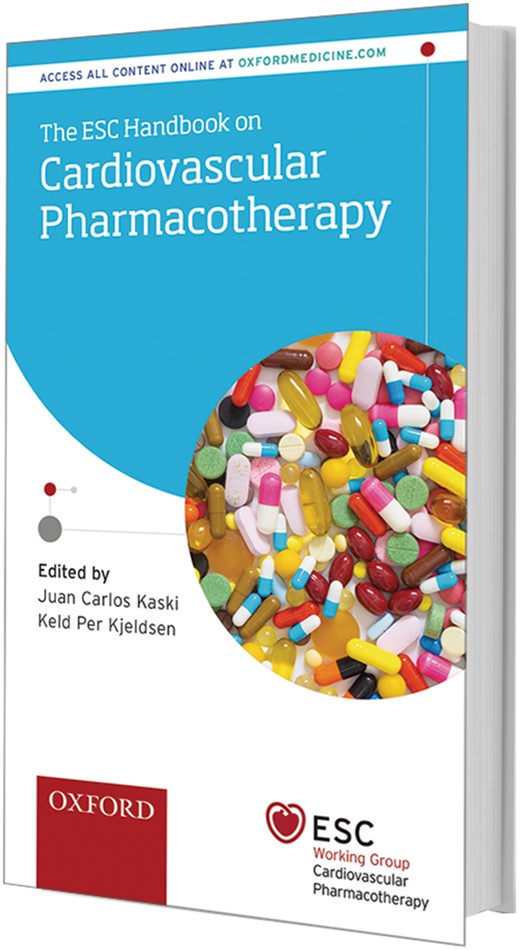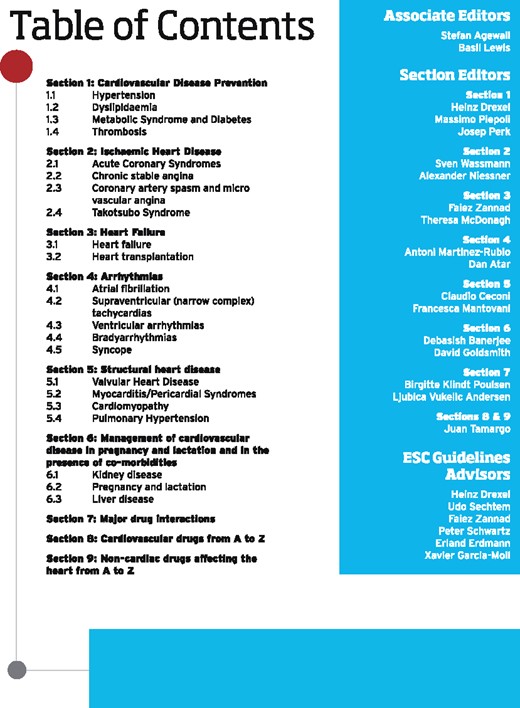-
PDF
- Split View
-
Views
-
Cite
Cite
Juan Carlos Kaski, Keld P Kjeldsen, Editors, on behalf of the Associate editors, Section editors, ESC Guidelines advisors, and chapter authors, Cardiovascular pharmacotherapy: a new ESC Handbook comprehensively addresses pharmacological treatment issues for patients with cardiovascular disease, European Heart Journal - Cardiovascular Pharmacotherapy, Volume 5, Issue 4, October 2019, Pages 185–186, https://doi.org/10.1093/ehjcvp/pvz019
Close - Share Icon Share
Cardiovascular pharmacotherapy plays a truly major role in the management of cardiovascular disease across its whole spectrum. Drug therapy has been shown to be a life-saving or life-prolonging intervention in many cardiovascular conditions and a quality of life enhancer in others, as a result of its role in the improvement of otherwise debilitating symptoms. Over the past few years, physicians have continued to witness—and benefit from—the arrival of large numbers of pharmacological agents which have objectively been shown to have beneficial effects. Among the areas that had benefited the most from this influx of newer pharmacological agents are dyslipidaemia, diabetes, coronary artery disease, heart failure, thrombosis and coagulation disorders, stroke prevention, and cardiac arrhythmias such as atrial fibrillation.
Albeit truly welcome by the medical community, the relentless arrival of newer pharmacological agents represents a major challenge to the busy practising physician, for a variety of reasons. Health practitioners not only have to be conversant with the indications, absolute contraindications, and appropriate dosages of the new drugs but also—and very critically—with their adverse effects, their interactions with other cardiovascular and non-cardiovascular agents, and their effects on other organs and systems. Physicians are also expected to be aware of the basic pharmacological characteristics of the drugs they prescribe and to ensure that their therapeutic decisions are based on solid evidence.
Individual patient responsiveness, the impact of polypharmacy, subtle differences between agents grouped within drug classes, and the role of age and gender regarding drug efficacy and undesirable effects are also critically important.
An interesting phenomenon has emerged in recent years, namely that pharmacological knowledge and drug management of specific diseases is commonly devolved to ‘disease-specific’ experts, a fact that reduces the involvement of the general practitioner in everyday life patient management. The therapeutic challenge is compounded by the increasing complexity of the management guidelines emanating from different international cardiac societies in their attempt to make their recommendations more exhaustive and applicable to every clinical situation.
In view of all of the above, the European Society of Cardiology (ESC) Working Group on Cardiovascular Pharmacotherapy has produced this Handbook on Cardiovascular Therapy, which aims at assisting physicians in their difficult task of prescribing wisely. The book is expected to facilitate access to practical information regarding cardiovascular diseases and their treatment, focusing on different aspects of pharmacotherapy as well as current recommendations for disease management. Previously published as ‘Drugs in Cardiology’, this fully revised handbook is aligned with the ESC Clinical Practice Guidelines (Figure 1).

In producing this Handbook, the Editors aimed at assisting several specific groups of health professionals who might find it useful to have access to up to date guidance on cardiovascular pharmacotherapy and disease management all contained within a single volume, namely cardiologists, general practitioners, internal medicine specialists, anaesthetists, clinical pharmacologists, geriatricians, obstetricians, and nurse consultants. Junior doctors and trainees in all of these specialties are also likely to find this book of help.
The content of the Handbook is presented in nine sections. Sections 1–5 provide a brief description of all major cardiovascular conditions (including prevention, ischaemic heart disease, heart failure, arrhythmias, and structural heart disease) and recommendations for management, in accordance with current ESC Clinical Practice Guidelines. Section 6 deals with the important problem of cardiovascular pharmacotherapy in pregnancy. This section also covers important aspects of cardiovascular pharmacotherapy in patients with kidney or liver disease. Section 7 focuses on drug interactions, a topic of extreme importance in clinical practice and one which is not frequently addressed in management guidelines. Last, but not least, sections 8 and 9 contain a comprehensive A–Z formulary of commonly and less commonly used cardiac and non-cardiac pharmacological agents, respectively, and both provide practical and accessible information on different aspects of pharmacology and pharmacotherapy. This will almost certainly help in streamlining drug prescribing and provide useful guidance for rational pharmacotherapy decision-making (Figure 2).

All chapters and sections of the book have been written and edited by international experts in their respective fields. Very importantly, to guarantee the accuracy of the therapeutic recommendations in the Handbook, the content in every chapter has been carefully scrutinized by the editors as well as by ESC Guidelines advisors appointed by the editors on the basis of their outstanding expertise in cardiovascular pharmacotherapy and acquaintance with ESC Clinical Practice Guidelines (Figure 2).
The book’s print edition comes with full access to its online version, allowing the reader to annotate and save chapters, download images, and follow links to references and guidelines. As cardiovascular pharmacotherapy is a rapidly evolving field, we will be reviewing the online content at yearly intervals to keep the book up to date for years to come, as appropriate. We also expect this Handbook to represent an interactive, dynamic, bidirectional process among the book contributors and the readers, and we thus will welcome suggestions from the readership that can help in improving the book content.
A substantial amount of time and effort has been put into the production of this work by all parties involved, often impacting on the professional, social, and family life of the authors who have contributed so generously to the project. The editors—like every individual taking part in the development of the ESC Handbook on Pharmacotherapy—will, however, feel sufficiently rewarded if the content of this book succeeds in assisting health practitioners in their endeavours to serve their patients better.



